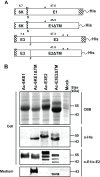Functional processing and secretion of Chikungunya virus E1 and E2 glycoproteins in insect cells
- PMID: 21762510
- PMCID: PMC3162542
- DOI: 10.1186/1743-422X-8-353
Functional processing and secretion of Chikungunya virus E1 and E2 glycoproteins in insect cells
Abstract
Background: Chikungunya virus (CHIKV) is a mosquito-borne, arthrogenic Alphavirus that causes large epidemics in Africa, South-East Asia and India. Recently, CHIKV has been transmitted to humans in Southern Europe by invading and now established Asian tiger mosquitoes. To study the processing of envelope proteins E1 and E2 and to develop a CHIKV subunit vaccine, C-terminally his-tagged E1 and E2 envelope glycoproteins were produced at high levels in insect cells with baculovirus vectors using their native signal peptides located in CHIKV 6K and E3, respectively.
Results: Expression in the presence of either tunicamycin or furin inhibitor showed that a substantial portion of recombinant intracellular E1 and precursor E3E2 was glycosylated, but that a smaller fraction of E3E2 was processed by furin into mature E3 and E2. Deletion of the C-terminal transmembrane domains of E1 and E2 enabled secretion of furin-cleaved, fully processed E1 and E2 subunits, which could then be efficiently purified from cell culture fluid via metal affinity chromatography. Confocal laser scanning microscopy on living baculovirus-infected Sf21 cells revealed that full-length E1 and E2 translocated to the plasma membrane, suggesting similar posttranslational processing of E1 and E2, as in a natural CHIKV infection. Baculovirus-directed expression of E1 displayed fusogenic activity as concluded from syncytia formation. CHIKV-E2 was able to induce neutralizing antibodies in rabbits.
Conclusions: Chikungunya virus glycoproteins could be functionally expressed at high levels in insect cells and are properly glycosylated and cleaved by furin. The ability of purified, secreted CHIKV-E2 to induce neutralizing antibodies in rabbits underscores the potential use of E2 in a subunit vaccine to prevent CHIKV infections.
Figures







Similar articles
-
Cell-based analysis of Chikungunya virus E1 protein in membrane fusion.J Biomed Sci. 2012 Apr 21;19(1):44. doi: 10.1186/1423-0127-19-44. J Biomed Sci. 2012. PMID: 22520648 Free PMC article.
-
A vaccine candidate based on baculovirus displaying chikungunya virus E1-E2 envelope confers protection against challenge in mice.J Virol. 2024 Nov 19;98(11):e0101724. doi: 10.1128/jvi.01017-24. Epub 2024 Oct 23. J Virol. 2024. PMID: 39440961 Free PMC article.
-
Expression and evaluation of Chikungunya virus E1 and E2 envelope proteins for serodiagnosis of Chikungunya virus infection.Yonsei Med J. 2008 Oct 31;49(5):828-35. doi: 10.3349/ymj.2008.49.5.828. Yonsei Med J. 2008. PMID: 18972604 Free PMC article.
-
Chikungunya virus and its mosquito vectors.Vector Borne Zoonotic Dis. 2015 Apr;15(4):231-40. doi: 10.1089/vbz.2014.1745. Epub 2015 Feb 12. Vector Borne Zoonotic Dis. 2015. PMID: 25674945 Review.
-
Chikungunya virus vaccine: a decade of progress solving epidemiological dilemma, emerging concepts, and immunological interventions.Front Microbiol. 2024 Jul 22;15:1413250. doi: 10.3389/fmicb.2024.1413250. eCollection 2024. Front Microbiol. 2024. PMID: 39104592 Free PMC article. Review.
Cited by
-
Next generation sequencing of DNA-launched Chikungunya vaccine virus.Virology. 2016 Mar;490:83-90. doi: 10.1016/j.virol.2016.01.009. Epub 2016 Feb 6. Virology. 2016. PMID: 26855330 Free PMC article.
-
Superinfection Exclusion in Mosquitoes and Its Potential as an Arbovirus Control Strategy.Viruses. 2020 Nov 5;12(11):1259. doi: 10.3390/v12111259. Viruses. 2020. PMID: 33167513 Free PMC article. Review.
-
Chikungunya E2 Protein Produced in E. coli and HEK293-T Cells-Comparison of Their Performances in ELISA.Viruses. 2020 Aug 26;12(9):939. doi: 10.3390/v12090939. Viruses. 2020. PMID: 32858804 Free PMC article.
-
Heterologous DNA Prime- Subunit Protein Boost with Chikungunya Virus E2 Induces Neutralizing Antibodies and Cellular-Mediated Immunity.Int J Mol Sci. 2023 Jun 23;24(13):10517. doi: 10.3390/ijms241310517. Int J Mol Sci. 2023. PMID: 37445695 Free PMC article.
-
Recombinant modified vaccinia virus Ankara expressing glycoprotein E2 of Chikungunya virus protects AG129 mice against lethal challenge.PLoS Negl Trop Dis. 2014 Sep 4;8(9):e3101. doi: 10.1371/journal.pntd.0003101. eCollection 2014 Sep. PLoS Negl Trop Dis. 2014. PMID: 25188230 Free PMC article.
References
-
- Gould E, Gallian P, De Lamballerie X, Charrel R. First cases of autochthonous dengue fever and chikungunya fever in France: from bad dream to reality! Clinical Microbiology and Infection. 2010;12:1702–1704. - PubMed
MeSH terms
Substances
LinkOut - more resources
Full Text Sources
Other Literature Sources
Medical

